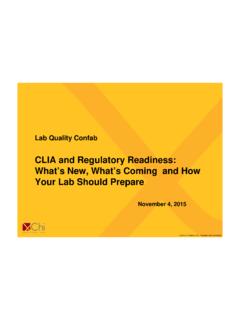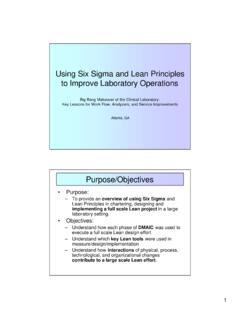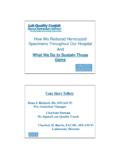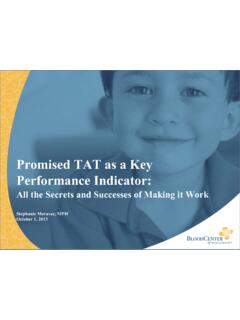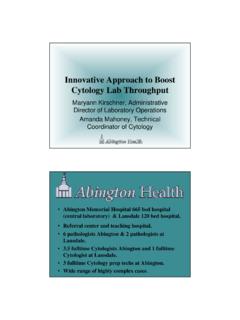Transcription of What is an LDT? - Lab Quality Confab
1 The DoThe Do s And Dons And Don ts of ts of Validating Laboratory Validating Laboratory Developed TestsDeveloped TestsDeirdre Astin, MS, MT (ASCP)Deirdre Astin, MS, MT (ASCP)Lab Quality Confab 2011 Lab Quality Confab 2011 November 2011 November 2011 San Antonio TexasSan Antonio TexasWhat is an LDT? what is an LDT? Laboratory developed tests (LDTs) are in vitro diagnostic tests that are developed, validated and used for in house clinical diagnostic purposes only by the laboratory that developed homebrew tests, laboratory developed assays (LDA s), proprietary testsLDTLDT ss Opportunities Opportunities Market and demand exists LDTs can be developed without FDA review and clearance Faster path to market responsive to emerging diseases and conditions Most genetic tests are LDT s not enough prevalence for large scale studiesLDTLDT ss Disadvantages Disadvantages Requires bridging the gap between R&D and clinical application Can require substantial investment Uncertainty in regulatory and accreditation requirements Laboratory assumes responsibility and risk for assay performance FDAFDA Then and NowThen and NowFDA s historically exercised enforcement discretion for LDT s because they.
2 Were relatively simple, well understood tests with low test volumes Were for rare diseases or unmet needs, Were intended to be used by physicians and pathologists in a single institution where they were actively involved in patient careFDAFDA Then and NowThen and Now Enforcement discretion reconsidered: Expanding LDT marketplace, increased distance from test developer to patient Government and media scrutiny High risk, high complexity tests, complex interpretation Tests aggressively advertised, developed by laboratories set up specifically for LDTs, marketed directly to consumers (DTC) Types of LDTT ypes of LDT ss FDA ActionsFDA ActionsHomebrew assays: 2003 guidance: assays that incorporate general purpose reagents and general purpose instruments IVDMIA s: 2006 and 2007 guidance: multiple values, non transparent result (score, index), require FDA clearanceASRs:2007 guidance: single target reagents; exempt from PMA if used with specific labeling and report disclaimer requirements; certain uses (combining, promoting) not allowedTypes of LDTT ypes of LDT ss FDA ActionsFDA ActionsRUO/IUO: draft guidance April 2011: manufacturer cannot market for diagnostic use or assist in validation; must halt salesif it discovers assays are being used for diagnostic purposes, or submit assay for FDA reviewDTC Genomics: from watchful vigilance in 2009 to enforcement letters in 2010, GAO reports Misleading Test Results, Deceptive Marketing and Questionable Practices.
3 Public hearings in March 2011, FDA forming a personalized medicine programTypes of LDTT ypes of LDT ss FDA ActionsFDA ActionsCompanion Diagnostics: Draft guidance July 2011: tests used to direct or monitor therapies should be cleared contemporaneously with the target drug or IVDThe FDA held two days of public meetings in July of 2010 to get feedback from regulators, industry and clinical practitioners on models for LDT Possibilities for LDTP ossibilities for LDT ss Full FDA review of LDT s as IVD s (by OIVD or a new branch ) Central registration or listing of LDT s CLIA approval of LDT s , through evaluation of developing laboratory Hybrid FDA/CLIA approach, based on risk stratification model Other Oversight ModelsOther Oversight Models CLIA: Surveyors look for documentation of validation for LDT s, LDT s =high complexity CAP: Proposes stratified requirements for validation based on risk, RUO s allowed only after laboratory documents no comparable ASR or FDA cleared assay exists Joint Commission: Follows CLIA model, supports FDA review and approval for high risk assays NYS: Must review and approve any LDT, RUO, IUO or modified FDA cleared assayValidating LDTV alidating LDT ss DoDo s and s and DonDon makes an LDT different from an FDA cleared IVD assay?
4 Examine the FDA s IVD clearance processAvoid the land The FDA Model: A Complete Product LifecycleANALYTIC VALIDITYCLINICAL VALIDITYPOSTMARKET PRE EXAMINATIONEXAMINATIONPOST EXAMINATIONLDT Development LDT Development Apply Quality Management Systems (QMS) Principles to FDA Validation ModelDESIGNLDT DevelopmentLDT DevelopmentFDA requires assays to be developed in a Quality systems environment Quality Systems Regulations (QSR) at 21 CFR 820 (Good Manufacturing Practices or GMP) FDA Guidance Document: Medical Device Quality Systems Manual; A Small Entity Compliance Guide First Edition Clinical laboratories are already subject to Quality QSR (GMP) ModelFDA QSR (GMP) ModelThe FDA Medical Device Quality Systems Manual:Design Controls Process Validation Personnel Buildings and Environment Equipment and Calibration Device Master Record Document and Change Control Purchasing and Acceptance Activities Labeling Product Evaluation Packaging Storage, Distribution, and Installation Complaints Servicing Quality Systems Audits Factory Inspections LDT Development LifecycleLDT Development LifecyclePHASE ONE: DESIGN: DO establish master policies and procedures for method validation a validation protocol.
5 Assay development who, what , where and how Pre defined expectations for assay performance Algorithms and statistics for assay validation Use of reference assays and/or clinical findings Subject and IRB compliance, if applicable On going validation, including QC, external assessments, and Quality assuranceLDT Development LifecycleLDT Development LifecyclePHASE ONE: DESIGN. DO consider the following : Intended Use: Define the analyte or target, purpose (diagnosis, screening) and population Qualitative or quantitative assay Sample Types: Serum, CSF, urine , other (validation must include all sample types) Variables to be considered (temperature, analyte and specimen stability, interfering substances) Limitations, safety and effectivenessLDT Development LifecycleLDT Development LifecyclePHASE ONE: DESIGN: DO develop a customized validation plan for each LDT, to include Authorities, roles ,responsibilities for personnel Necessary equipment, supplies and budget Define what will be measured Design how will it be measured Determine how many will be measured(statistical significance) Define acceptance/rejection criteria and how discrepant results will be handled Define required documentation and a system of document controlLDT Development LifecycleLDT Development LifecyclePHASE ONE: DESIGNDO use tried and true methods to evaluate performance characteristics: two options: Comparison of results between new method and reference or gold standard method Evaluate results using new method on certified reference materials (recovery)Guidance on validation available from the FDA.
6 User friendly guides being developed by CLSI, with review by the FDA, expected in 2012 LDT Development LifecycleLDT Development LifecyclePHASE TWO: ANALYTIC EVALUATIONDoes the assay detect what it is designed to detect in an accurate and reproducible manner? Performance characteristics include: Accuracy aka Trueness Precision (reproducibility) Sensitivity (limits of detection/quantitation) Specificity (cross reactivity or interferences) Linearity or analytic measurement rangeLDT Development LifecycleLDT Development LifecyclePHASE TWO: ANALYTIC EVALUATIONDO use FDA recognized standards for analytic validation , CLSI (also accepted by CAP and JC)EP05 Evaluation of PrecisionEP06 Evaluation of LinearityEP09 Evaluation of Bias and Comparability Using Pt. SamplesEP10 Preliminary Evaluation (Bias, Carryover, Drift, Linearity)EP12 Evaluation of Qualitative TestsEP17 Limits of Detection and Limits of QuantitationC28 Defining, Establishing and Verifying Reference IntervalsGP10 Assessment of the Clinical Accuracy of Laboratory Tests Using Receiver Operating Characteristic (ROC) organize your method validation dataLDT Development LifecycleLDT Development LifecyclePHASE TWO: ANALYTIC EVALUATION: DO conduct statistical analysis using established methods: StatisPro: a Windows software based on CLSI EP validation guidelines assists in study design , data gathering, aggregation, and review for all required parameters FDA: FDA Laboratory Procedure Manual: NIH, National Genome Research InstituteLDT Development LifecycleLDT Development LifecyclePHASE TWO.
7 (POST) ANALYTIC EVALUATIONDO design a customized Quality control strategy that takes into account performance, risks and limitations of your assay. EP23 A, Laboratory Quality Control Based on Risk Management: New protocol from CLSI that addresses factors to be considered in QC design Discipline specific guidance: NIH, ASM, AACC DO establish clinical validity and clinical utilityLDT Development LifecycleLDT Development LifecyclePHASE THREE: CLINICAL EVALUATON. Clinical Validity: Does the result correlate with clinical condition or patient outcomes? Clinical sensitivity: Pos. result = condition Clinical specificity: Neg. result = no condition Positive and negative predictive values (sensitivity and specificity vs. prevalence) Clinical reference range Panic or alert valuesLDT Development LifecycleLDT Development LifecyclePHASE THREE: CLINICAL EVALUATON Clinical Validity: DO s DO use characterized specimens for assay validation (known clinical condition) DO document and adhere to clinical indications for testing (for LDT s, the lab defines intended use) DO provide robust test descriptions and interpretive information on patient reports DO reference reputable and current peer reviewed literatureLDT Development LifecycleLDT Development LifecyclePHASE THREE: CLINICAL EVALUATON Clinical Utility: FDA requirements at 21 CFR 860 Clinical effectiveness.
8 Reasonable assurance that the use of the device will provide clinically significant results Test association with improved clinical outcomes or Quality of life and its usefulness to patient and clinician decision making Safety: reasonable assurance that the probable benefits outweigh any risksLDT Development LifecycleLDT Development LifecyclePHASE THREE: CLINICAL EVALUATON. Clinical Utility Most difficult parameter to measure/predict; requires analysis of multiple variables and correlation with clinical outcomes Developing laboratory not required to establish clinical utility (per CLIA) but due diligence should be demonstrated DO research literature, survey end users, track clinical outcomes, design and participate in long range studies including economic utilityLDT Development LifecycleLDT Development LifecyclePHASE FOUR: POST MARKET SURVEILLANCEDoes the assay continue to behave as expected?
9 FDA conducts post market surveillance of cleared IVD s through its Medwatch system Tracks adverse events and ensures manufacturer responds Actions can include relabeling, recallsLDT Development LifecycleLDT Development LifecyclePHASE FOUR: POST MARKET SURVEILLANCEDoes the assay continue to behave as expected? Quality Control External Assessment Non Conforming Events Complaints Clinical Correlation Laboratories have options to track LDT performance post market: LDT Development LifecycleLDT Development LifecyclePHASE FOUR: POST MARKET SURVEILLANCEDoes the assay continue to behave as expected? DO document non conforming events and complaints; take corrective action and redesign as appropriate (reactive) DO use Quality control, external assessments and Quality assurance monitors (proactive) DO collect data to demonstrate clinical validity and clinical and economic utility (forward thinking)Other LDT DOOther LDT DO ssDO subject validation records to document control Prepare summary report of validation (use assay validation plan as a template, retain and reference original data, , worksheets, instrument printouts)
10 Have protocol for review and approval of report by designated laboratory leadership Document any revalidation and verification to support modification of the assayOther LDT DOOther LDT DO ssDO retain samples used for validation, if possibleDO document any algorithms , statistical or automated calculations to validation DO comply with regulatory and accreditation requirement as for any other laboratory test: SOPs; training and competence , external assessments or other measures of accuracy (internal blinded specimens, duplicate analysis by different systems/staff)LDT DONLDT DON TsTsDON T develop an LDT if a generally accepted FDA assay already exists, unless you can document why your test is better. Think twice about RUOs/IUOSDON T allow validation by the developing entity , R&D department maintain objective validation protocols by a separate team and standardize them across all sections of the labDON T be driven by market forces use good science, transparency and realistic claimsDonDon t get your LDT in the newst get your LDT in the newsLDTLDT s in the Newss in the NewsGENOME WEB DAILY NEWSR esponding to FDA, LabCorp Discontinues Offering OvaSure TestConcerns from clinicians and professional organizations
